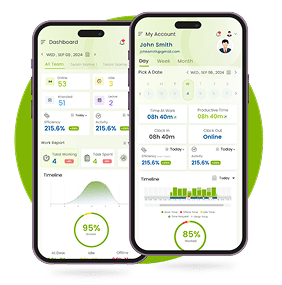Layoffs have become the corporate reset button, but they don’t have to be. Most companies don’t face a talent problem; they face a visibility problem.
When inefficiencies go unnoticed, workload imbalances are ignored, and employee wellness declines silently, layoffs often become the desperate fix to an avoidable problem.
The truth is, layoffs are not inevitable; they’re predictable. And with smart time tracking software, organizations can uncover those red flags long before they escalate into crises.
In this article, we’ll explore;
How does time tracking prevent layoffs?
Smart time tracking avoids layoffs by giving leaders visibility into how work hours are used. It identifies inefficiencies, unmanaged idle time, and uneven workload distribution, allowing managers to make adjustments before costs rise. With accurate data from tools like Desklog, companies can boost productivity and stabilize teams instead of cutting staff.
1. The Real Reason Layoffs Happen (And Why It’s Preventable)
Hidden Inefficiencies Drain Budgets Silently
Layoffs rarely happen overnight; they build up over months of unnoticed inefficiency. Small pockets of unproductive time, duplicated tasks, and underutilized roles silently drain budgets. Without the right visibility, managers often misread these issues as performance failures instead of process failures. That’s where Desklog’s automatic time tracking and project time tracking change the game.
With these features, Desklog gives a complete picture of how work hours are spent. This helps identify bottlenecks, duplicated efforts, and low-value tasks, allowing leaders to redirect resources effectively instead of cutting them.
When teams can see patterns like idle-time tracking, frequent context switching, or unbalanced workloads, operational leaks can be fixed before they threaten profitability and before layoffs become the fallback solution. Smart visibility ensures you avoid layoffs through efficiency, not emergency.
Lack of Visibility Leads to Delayed Action
Most layoffs occur not because businesses lack revenue but because they lack real-time visibility. By the time leadership notices a drop in output or rising costs, it’s already too late to make efficient adjustments.
Desklog’s automated timesheet features bridge this visibility gap. They turn scattered productivity data into actionable intelligence, showing who’s overworked, who’s underutilized, and which processes drain time.
This level of insight enables HR teams to make data-driven decisions early, from workload distribution to refining project timelines, one of the most effective strategies on how to avoid layoffs by acting before financial imbalance snowballs.
The Human Cost of Reactive Layoffs
Layoffs carry more than financial costs; they erode trust, morale, and company culture. Employees who survive often experience lower employee engagement, guilt, and reduced productivity. Meanwhile, the company faces lost expertise and rehiring expenses.
Recent studies show that retraining a mid-level employee can cost up to 1.5x their annual salary. By providing early visibility into employee productivity and workload balance, Desklog helps leaders act proactively, maintaining morale, saving jobs, and protecting brand reputation.
With better workforce data, organizations can stabilize performance and avoid layoffs by optimizing resources long before crisis management becomes necessary.
See how time tracking exposes hidden inefficiencies before they become costly mistakes. Discover Smarter Workflows with Desklog
How Smart Time Tracking Creates Workforce Stability
Real-Time Data Turns Guesswork Into Clarity
In most organizations, decisions about workload or hiring rely on assumptions rather than time efficiency. Desklog replaces this guesswork with clear, real-time insights.
Every tracked minute builds a dynamic picture of team output through team time management dashboards, showing project progress, utilization rates, and trends in focus time.
This clarity helps companies avoid layoffs caused by misunderstanding productivity metrics. When HR can identify early dips in efficiency or focus, they can support teams with training, improved processes, or better workload management, instead of resorting to cuts.
Identify Underutilized Employees Before It’s Too Late
One of the most overlooked ways to avoid layoffs is by recognizing underutilized potential. Many layoffs target employees perceived as redundant when, in reality, they’re simply underutilized. Desklog’s performance insights reveal how each employee’s time contributes to productive outcomes, helping managers recognize hidden potential.
With insights into task time mapping and subtask management, leaders can repurpose talent instead of releasing it. By reassigning employees to new projects or upskilling them based on tracked patterns, businesses preserve valuable human capital and prevent premature downsizing.
Balance Workloads Across Teams Automatically
Workload imbalance is a silent productivity killer. When some employees are overwhelmed while others are underused, employee burnout and inefficiency follow. Desklog’s productivity graphs visualize real-time workload distribution across teams.
With attendance management and clock in & clock out tracking, managers can fairly distribute tasks and ensure balanced work hours. Balanced workloads not only prevent burnout but also improve overall employee satisfaction and reduce employee absenteeism in the workplace, keeping teams stable even during uncertainty.
Tracking Utilization Rates Prevents Over-Hiring
Businesses often over-hire when they can’t accurately measure current team capacity. Desklog’s utilization analytics and billable vs. non-billable tracking give precise visibility into how time is spent.
With clear insights into project billing & invoice and project profit & loss, companies can align staff size with real project demand, ensuring efficient scaling without overspending or future layoffs.
Predictive Analytics Prevent Sudden Cost Spikes
Financial instability usually stems from gradual inefficiencies, missed deadlines, prolonged idle time, or untracked billable hours. Desklog’s predictive analytics highlight these trends early, giving leaders the ability to prevent project cost overruns before they occur.
Rather than resorting to layoffs, managers can address root causes like workflow misalignment or productivity drops, maintaining stability through precision and foresight.
Data-Driven Staffing Keeps Projects Profitable
Profitability depends on aligning effort with outcomes. When time spent doesn’t match billable output, profit margins shrink. Desklog’s integration of project time tracking with project billing ensures that every hour is accountable and profitable.
By measuring employee productivity accurately, companies can keep operations cost-efficient and maintain stable teams even under changing market conditions.
The Hidden Link Between Employee Wellness and Layoff Prevention
Burnout Is the Invisible Productivity Killer
Employee burnout is one of the top contributors to declining performance. Without tracking focus time or energy levels, companies often mistake exhaustion for inefficiency.
Desklog’s employee wellness module tracks focus patterns, break & overtime notifications, and fatigue trends, allowing managers to step in before burnout impacts team stability.
This proactive insight reduces stress-related absenteeism and preserves both well-being and workforce consistency.
Timed Breaks Sustain Focus and Reduce Attrition
Continuous work reduces cognitive performance and increases errors. Desklog structures timed breaks and healthy work rhythms that sustain energy without sacrificing output.
Companies that integrate Desklog’s wellness data often notice higher engagement, reduced attrition, and longer focus periods, essential factors for retaining talent and maintaining work-life balance.
Wellness Data Helps HR Balance Performance Expectations
Performance management that ignores wellness leads to unsustainable pressure. Desklog combines wellness analytics with employee accountability metrics, enabling HR to set realistic performance goals that align with human capacity.
This data-backed balance ensures employees perform steadily, stay longer, and support a culture of sustainable growth, the most effective, long-term strategy for how to avoid layoffs while scaling responsibly.
Find the sweet spot between productivity and wellbeing. Let data guide a balanced work culture. See How Desklog Promotes Healthy Productivity.
Find the sweet spot between productivity and wellbeing. Let data guide a balanced work culture. See How Desklog Promotes Healthy Productivity.
Why Desklog Is Built for Workforce Stability
Automated Analytics and Utilization Tracking
Turning Data into Predictive Intelligence
Desklog’s automated analytics convert real-time data into visual trends that highlight performance patterns and
utilization rates. Instead of viewing hours worked, leaders see how time translates into value; tracking
engagement, focus duration, and project outcomes.
Preventing Burnout and Resource Imbalance
When the system detects inconsistent workloads or extended focus hours, it signals early warnings. This helps HR
and managers reassign resources, ensuring balanced workloads that sustain productivity and morale across teams.
Connecting Effort to Organizational Goals
Through detailed
project time tracking, Desklog links effort to profitability, allowing organizations to compare productivity
trends with business results. This creates a clear path between employee contribution and company performance.
Ethical & Transparent Employee Tracking
Building a Culture of Accountability
Unlike conventional surveillance tools, Desklog operates with transparency at its core. Its time tracking and
optional screenshot features are designed for visibility, not control. Employees can access their own data,
review trends, and understand their performance in relation to goals.
Encouraging Employee Trust Through Openness
Transparency promotes a balanced work culture where employees feel respected and informed. This clarity ensures
that productivity measurement isn’t perceived as pressure, but as a shared tool for progress.
Responsible Insights, Not Micromanagement
Desklog’s tracking structure reinforces ethical usage by prioritizing privacy and respect. Insights are
contextual, focused on output quality and focus patterns rather than constant supervision.
Custom Insights for Every Role
For Managers: Clarity in Resource Allocation
Desklog’s dashboards help managers oversee team performance in real time. With access to utilization trends,
attendance analytics, and project cost reports, they can balance workloads, improve coordination, and make
data-backed staffing decisions that enhance productivity and reduce operational strain.
For HR Leaders: Understanding Workforce Health
HR professionals gain deep visibility into attendance, engagement metrics, and absence trends through Desklog’s
analytics. By combining this data with wellness indicators, HR teams can identify early burnout risks, optimize
employee satisfaction, and strengthen retention through proactive workforce planning.
For Founders & Executives: Insight-Led Forecasting
Desklog equips leadership teams with clear insights into workforce output, cost efficiency, and project-level
profitability. These data points enable long-term forecasting, budget accuracy, and strategic decision-making
that supports sustainable growth and organizational stability.
For Employees: Clarity, Balance & Growth
Desklog empowers employees with personal performance visibility, helping them track productive hours, identify
focus patterns, and maintain work-life balance. With transparent data and wellness feedback, individuals can
align their goals with company objectives while fostering consistent professional growth.
Conclusion: Cut Waste, Not People
Layoffs happen when businesses lack visibility, not when they lack talent. With Desklog’s smart time tracking, organizations can identify inefficiencies, prevent burnout, and make informed decisions that sustain stability.
By giving leaders the power to measure employee productivity, balance workloads, and protect wellness, Desklog turns reactive cost-cutting into proactive optimization.
Smarter Time. Stronger Teams. Sustainable Growth.
Build a culture that values smart effort over long hours. Use insights that sustain growth without burnout.
FAQs
1What is smart time tracking?
Smart time tracking uses automation to record how employees spend work hours. It minimizes manual input, tracks productivity, and ensures accurate project billing and performance measurement.
2How does time tracking improve project profitability?
By using project time tracking tools like Desklog, managers can identify billable and non-billable hours, track project costs, and reduce time wastage, directly improving project ROI.
3Can time tracking help reduce employee burnout?
Yes. Smart tracking reveals workload distribution, overtime, and idle hours. With features like break and overtime notifications, Desklog promotes a balanced workflow and prevents burnout.
4What role does time tracking play in remote employee management?
It provides transparency and accountability. Tools like Desklog’s web timer and automated timesheets help track remote team efficiency and ensure consistent productivity across locations.
5How does Desklog track offline work?
Desklog’s offline time tracking feature records time spent on tasks even when users are disconnected from the internet, syncing data once the connection is restored.
6What are the benefits of using an automated timesheet?
Automated timesheets eliminate manual errors, provide accurate attendance data, and simplify payroll, billing, and project analysis for managers.
7How can companies ensure employee wellness with time tracking?
Desklog’s Employee Wellness Module tracks work patterns, break habits, and focus time to support balanced workloads and improved employee satisfaction.
8Does time tracking improve team performance?
Yes. By offering clear visibility into productive and idle hours, time tracking tools enhance employee accountability, focus, and performance consistency.
9How does Desklog manage attendance in remote teams?
Desklog’s attendance management software automates check-in, clock-in, and shift scheduling, helping managers track attendance without micromanaging remote employees.
10What trends define the future of employee productivity?
Future trends include automated performance analysis, focus-time tracking, employee engagement insights, and advanced project cost tracking, all key elements already integrated into Desklog’s ecosystem.
















